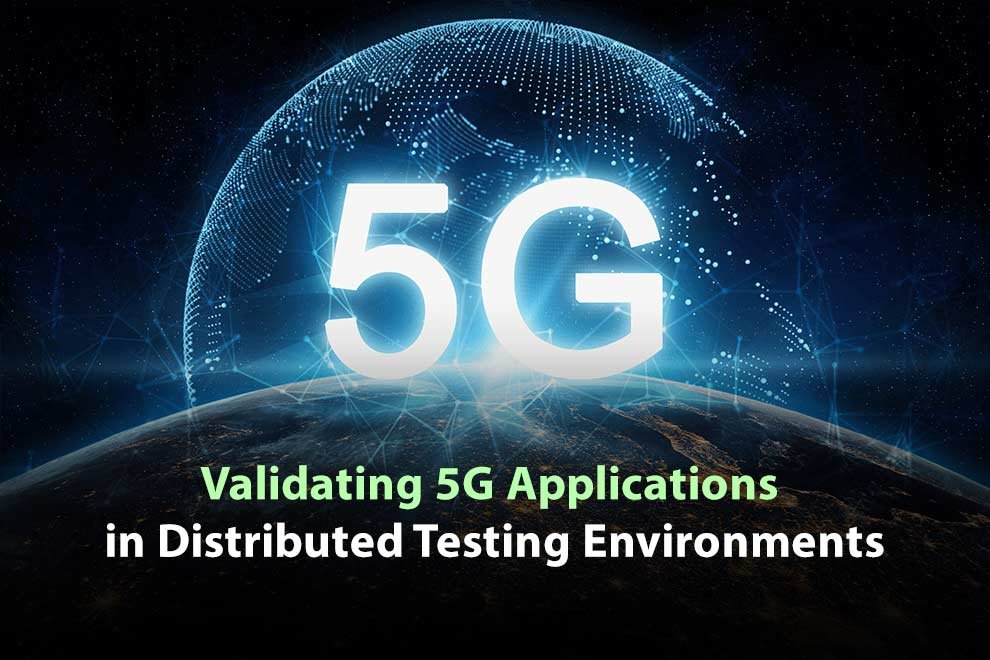With the potential for faster data transfer, low latency, and wide device connectivity, 5G technology has completely changed communication. The advent of 5G technology has significantly reshaped how industries operate, offering immense potential with faster data transfer speeds, reduced latency, and broader connectivity. Various sectors, including healthcare, automotive, smart cities, and the Internet of Things (IoT), utilize cloud mobile testing technology to enhance their operations.
Cloud mobile testing has become an essential method for organizations striving to validate their app’s seamless functionality in distributed testing environments through scalable cloud infrastructure. Nonetheless, guaranteeing the reliability, security, and efficiency of these applications necessitates strong testing frameworks capable of accurately simulating real-world scenarios.
Mobile testing in the distributed testing setup enables thorough testing across various networks, edge computing nodes, and cloud infrastructure by incorporating various test nodes located in different geographic areas. This ensures that 5G applications operate efficiently under diverse network conditions.
This article analyzes the importance of distributed testing environments, essential approaches for verifying 5G applications, and the difficulties encountered in guaranteeing performance, compatibility, and security. By implementing creative testing methods, organizations can reduce risks and improve the dependability of 5G applications in practical implementations.
Characteristics of 5G applications
5G applications display distinct features that necessitate sophisticated validation methods:
High speed and minimal delay– 5G networks are ideal for applications like healthcare, virtual reality, and augmented reality (AR) because of their incredibly fast data transfer rates and minimal latency. Simulating real-time data transfer scenarios in a dispersed environment is necessary for evaluating these applications.
Network slicing– 5G enables numerous virtual networks to operate on one physical framework, facilitating personalization according to application requirements. Testing must verify that each slice retains its performance, security, and resource distribution across different distributed test nodes.
Edge computing integration– By handling data nearer to end-users, edge computing improves performance and decreases latency. Testing in a distributed setting must evaluate how applications perform across various edge nodes and cloud data centers, guaranteeing smooth processing and data transfer.
Extensive IoT connectivity– 5G facilitates widespread IoT implementations by accommodating millions of connected devices. Testing methods must assess device compatibility, connection reliability, and data transfer across different network conditions in a distributed setting.
Dynamic network situations– Unlike conventional networks, 5G networks flexibly modify bandwidth, latency, and routing by real demands. Testing should replicate different network conditions in various geographical areas to guarantee application resilience and flexibility.
Understanding Distributed testing environments
A testing environment designed to evaluate an application’s functionality, performance, security, and interoperability over multiple geographically dispersed test nodes is known as a distributed testing configuration. By combining cloud computing, edge infrastructure, network emulation, and AI-powered automation, these settings successfully replicate real-world 5G rollout scenarios. Because 5G applications rely on complex, dynamic, and diverse network conditions that must be validated in real-world scenarios, distributed testing is crucial.
Organizations can assess application performance under variable network loads, signal intensities, and latencies by running tests in many locations, guaranteeing resilience in a variety of settings. Furthermore, compared to traditional testing techniques, distributed testing enables parallel execution, scalability, and real-time monitoring, enabling a more comprehensive and efficient evaluation of 5G applications.
Key components of distributed testing environments
Various key components of distributed testing environments in validating 5G applications are as follows:
Platforms for test orchestration: These services manage the execution of tests over multiple dispersed nodes, guaranteeing seamless coordination of test cases, execution schedules, and data gathering.
Network emulators and simulators: With the use of network emulators and simulators, testers can replicate real-world 5G network conditions, including fluctuating bandwidth, latency, and signal strength under different conditions.
Edge and cloud infrastructure: By providing realistic deployment scenarios where applications are tested across several locations and network levels, cloud and edge computing greatly aids in distributed testing.
AI and machine learning: Using historical data, AI-powered analytics can identify anomalies, improve test coverage, and predict possible failures.
Security testing frameworks: To protect apps from online attacks, these frameworks assess vulnerabilities, carry out penetration tests, and preserve data integrity.
Systems for remote monitoring and logging: Real-time monitoring solutions give insight into network performance, application behavior, and security risks across dispersed test locations.
Traffic generators and load testing tools: Testers can assess application performance under various traffic loads and congestion scenarios by using load testing tools and traffic generators, which simulate actual network traffic circumstances.
Collaboration and reporting tools: To facilitate analysis and decision-making, distributed testing environments demand smooth communication between teams that are spread out geographically. This calls for integrated reporting and collaboration platforms.
Methodologies for validating 5G application
Below are some of the vital methodologies for validating 5G applications in distributed testing environments:
Functional testing- This type of testing confirms that 5G applications function as per their specifications. This consists of:
- Unit testing – Unit testing, confirms the functionality of separate application elements.
- Integration testing – This evaluates the interaction among various application components.
- End-to-end testing – It emulates real-life scenarios to verify complete application performance.
Performance testing- Performance testing assesses how 5G applications behave under various network conditions. This encompasses various types of testing, they are:
- Throughput testing – In this type of testing it assesses data transfer speeds.
- Latency assessment – This identifies response times across different network loads.
- Scalability testing – Scalability testing evaluates application performance when subjected to higher user and data loads.
Security testing- This detects weaknesses and guarantees data safety in 5G applications. This comprises of:
- Penetration testing – It is a simulated attack used to evaluate the security of a system. The same methods used by malicious attackers are also used by ethical hackers. This mimics cyberattacks to identify vulnerabilities.
- Encryption and Authentication Assessment – This entails assessing an application’s security by looking at how users are authenticated and data is encrypted, looking for flaws like weak encryption algorithms, unsafe key management, or faulty authentication techniques. It also verifies security measures.
- Data integrity testing – This confirms that data is sent securely and stays unchanged.
Compatibility testing- The method of testing for interoperability determines if various systems can cooperate as planned. It ensures smooth operation across a range of 5G infrastructures, devices, and networks. This encompasses:
- Cross-network assessment – This assesses application performance across various operators and network segments.
- Device compatibility testing – It verifies app performance on different 5G-capable devices.
- Protocol conformance testing – This testing confirms compliance with 5G standards and industry specifications.
Edge computing evaluation- This evaluates application functionality when implemented on edge computing nodes, guaranteeing minimal latency and optimal efficiency during real-time processing.
AI-Powered Testing- This employs artificial intelligence and machine learning to improve test coverage, automate the execution of test cases, and forecast system failures.
Challenges in 5G application validation
There are several hindrances in 5G application validation in a distributed testing environment. Below are some of the challenges:
Latency and real-time requirements – A major promise of 5G is extremely low latency, essential for applications like autonomous vehicles, remote medical procedures, and industrial automation. Replicating real-world latency conditions in a testing environment is difficult, as delays in data transfer can be affected by numerous external factors such as network congestion, geographic distances, and processing overhead.
Intricate network structure – The structure of 5G networks comprises various interconnected elements like core networks, radio access networks (RAN), and edge computing nodes. This complexity hinders the creation of practical and thorough testing environments. Achieving smooth connectivity, effective data routing, and compatibility among various components necessitates comprehensive testing frameworks, which can be challenging to establish in conventional testing environments.
Significant infrastructure expenses – Implementing a distributed testing setup for 5G applications necessitates considerable financial outlay for cutting-edge hardware, applications, cloud testing services, and network emulators. Setting up test nodes in various locations, guaranteeing real-time data synchronization, and upholding high-performance servers contribute to operational costs, rendering large-scale testing an expensive undertaking.
Security weaknesses – The widespread adoption of 5G applications heightens the risk of cyber dangers, such as Distributed Denial-of-Service (DDoS) attacks, data leaks, and network breaches. Security testing within a distributed environment necessitates thorough evaluations of encryption systems, access control measures, and vulnerability assessments. Nevertheless, examining every potential attack vector in distributed networks is a complicated endeavor that demands ongoing surveillance and preemptive mitigation tactics.
Compatibility challenges – 5G networks function alongside current communication technologies like 4G LTE, Wi-Fi, and satellite systems. Achieving smooth compatibility among various network infrastructures, hardware devices, and application protocols presents a considerable challenge. Applications need to be evaluated on various network operators and device setups to ensure uniform performance and smooth transitions between different network types.
Tools and technologies to overcome the challenges
Below are some of the tools and technologies to overcome the challenges in 5G validation in a distributed testing environment:
Cloud-based testing platforms
Establishing and managing an internal infrastructure for testing requires significant time and often faces scalability challenges. The scalability issues arise when testing across various devices, operating systems, and network conditions, especially in dynamic environments like 5G applications. Scalable and adaptable solutions for testing 5G apps in distributed environments are offered by cloud mobile phone testing platforms like LambdaTest.
Given the complex, distributed nature of 5G networks, the platform provides testers with flexible, on-demand infrastructure to verify mobile app performance on a wide array of devices and various network conditions, which is crucial for 5G app testing. Testers can quickly scale up or down based on their testing needs without the overhead of managing physical infrastructure. This flexibility and scalability make it easier to simulate real-world scenarios for 5G apps across diverse geographic locations, ensuring more reliable performance and faster time-to-market.
LambdaTest is an AI-powered platform for test orchestration and execution that offers continuous quality testing, enabling developers and testers to deliver code more quickly. Its cloud for testing browsers and apps enables users to conduct both manual and automated tests for web and mobile applications on over 3000 diverse browsers, actual devices, and operating system environments. Organizations may effectively undertake parallel testing, replicate actual network scenarios, and guarantee consistent performance across various mobile devices and OS systems by utilizing cloud-based testing.
Network emulation tools
Instruments like iTrinegy and Keysight Network Emulators allow testers to simulate different 5G network scenarios, covering latency changes, bandwidth shifts, and signal disruptions. These tools aid in evaluating application performance across various levels of network congestion and guarantee resilience in actual situations.
Edge computing testing solutions
The incorporation of edge computing within 5G networks allows testing frameworks like FogComputingTest and OpenEdgeSim to verify application performance at the edge. These tools evaluate latency-critical processes, data alignment, and real-time analysis, guaranteeing smooth functioning in distributed settings.
Interoperability testing platforms
Achieving smooth communication among various network operators, devices, and protocols necessitates strong interoperability testing tools. Tools like Spirent and Keysight IxLoad enable the verification of 5G applications across various networks, guaranteeing seamless shifts between Wi-Fi, LTE, and 5G.
Security testing solutions
By doing penetration testing, encryption validation, and data integrity analysis, cybersecurity tools like Burp Suite, Wireshark, and Nessus assist in locating vulnerabilities in 5G apps. In a distributed testing environment, these techniques reduce the dangers of DDoS attacks, illegal access, and data breaches.
Conclusion
In conclusion, as 5G technology progresses, testing methods need to improve to address the growing complexity and dynamic characteristics of these networks. Validating 5G applications in distributed settings is crucial to guarantee performance, security, scalability, and compatibility under various network conditions. Utilizing a distributed testing method enables thorough evaluation in practical situations, tackling critical issues like latency limitations, security risks, and network overload.
Moreover, by utilizing cloud-based solutions such as LambdaTest, AI-powered automation, and tools for real-time performance monitoring, organizations can carry out effective and dependable validation procedures.










